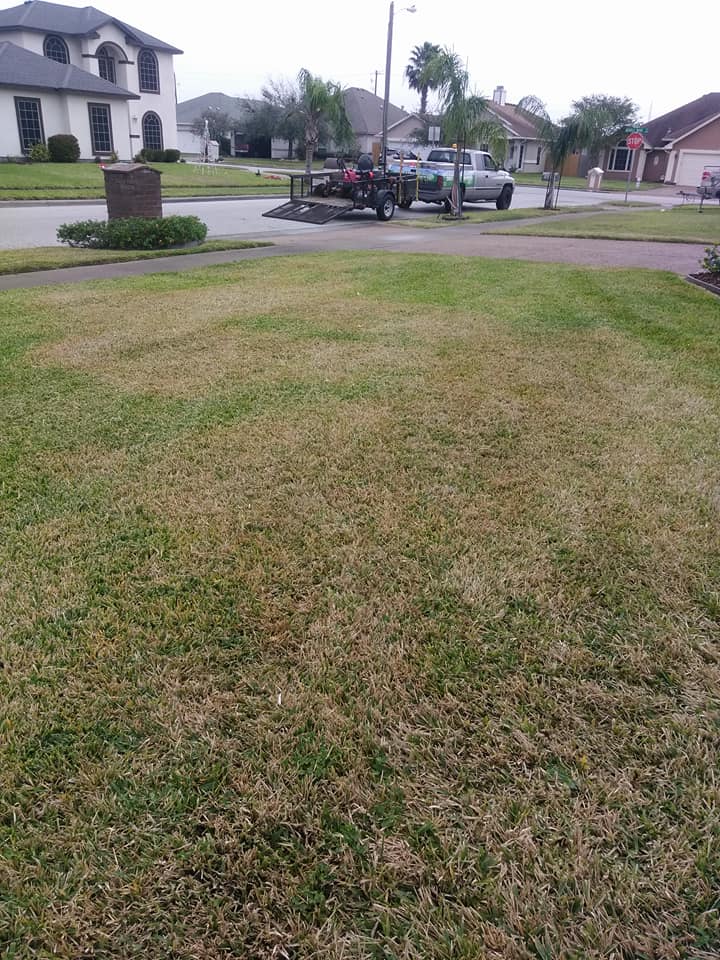So you finally thought you had your lawn in tip top shape and all of a sudden your St. Augustine Grass gets covered in large brown patches, and this time it wasn't your neighbors dog. Large brown patches now cover your lawn and you just don't know what to do.

But Here's the thing, you are not alone your lawn can be revived!
St. Augustine grass, is a popular thick growing warm season grass, that easily keeps most weeds at bay. Unfortunately it is susceptible to brown patches which most commonly occur in early spring and late fall. But what do you do to get your green lawn back, and how can this be prevented from happening again?
What causes brown patches in St. Augustine Grass?
St. Augustine Grass is susceptible to a type of fungus aptly called brown patch fungus. Brown patch fungus unsurprisingly causes large brown patched in the lawn. Brown patch fungus proliferates in cool wet conditions.
Maintaining your yard properly can prevent this type of fungus from destroying your lawn. Most steps for patch fungus prevention are typical for maintaining any yard, but St. Augustine grass can be a bit more sensitive.

For more on taking care of any lawn check out out The Ultimate Lawn Care Guide
6 Steps to prevent brown patch fungus in your St. Augustine grass:
Step 1: What time is it? Time to get a watch or at least a water timer. Don't Water at the wrong time!
Watering the lawn too late in the day will leave the lawn damp at night. This is especially problematic in the cooler months as this is precisely the conditions brown patch mold thrives in.
Instead water in the early morning, preferably at sunrise. This will give the grass blades time to dry before nightfall.
Step 2: It's true your grass needs water, but not too much! Don't drown your lawn.
Watering too frequently causes the damp conditions that brown patch mold loves. St. Augustine grass should only be watered once it is dry and showing signs of drought, typically every 5- 10 days. St. Augustine grass is semi-drought tolerant, and does best when watering is done only as needed
The recommended depth to water St. Augustine grass is 4- 6 inches. This is not 4-6 inches of water, but instead the depth into ground which the water is reaching. Based on your lawns drainage, the amount of water needed could vary.
Step 3: Avoid Using Nitrogen rich fertilizer in early spring and late Fall. The only thing in common with brown patch mold and you, is you both like fresh green grass.
Nitrogen fertilizer promotes lush green growth, and this soft growth is just what brown patch fungus enjoys. This new growth provides a nice platform for the fungus to grow on. Fertilizing too early or late can lead to fungus growth. Instead use nitrogen fertilizer only in late spring or in the summer.
Step 4: Ensure good drainage and treat compacted soil.
Compacted soil provides poor drainage, again leading to a lawn with too much surface moisture. Avoid this problem by aerating your lawn at least once a year, and maintaining a good PH in your law.
Step 5: Control your Clippings!
To avoid spreading the brown fungus control your grass clippings by mowing your yard regularly. Mowing your yard every ten days to a height of 2.5 - 3 inches is optimal for St. Augustine grass. Timely maintenance will avoid too many clippings from building up. If you want to cut the grass shorter, you will need to cut it more frequently.
You want to keep clippings from clumping up and creating too much thatch, thatch can also lead to excess moisture.
Step 6: Want Faster Results Using Fungicide Early May be your Key
Using fungicide early can be an effective way to control brown patch mold. There are many fungicides to chose from, and the one you chose will be largely dependent on what is available in your area, as well as the type of application that works best for you. Whichever fungicide you decide on, follow the instructions on the packaging. Most fungicides will need to be applied once or twice a month. For the best results, be certain to begin use fungicide at the first signs of brown patch fungus.

As you can see, the main concept of all of the steps to preventing brown patch fungus is to avoid excess moisture in your lawn.
Following this simple guide will help you avoid the horrors of brown patches in your lawn. Be sure to maintain your yard properly to avoid brown patch fungus. But, if you have the misfortune of having brown patch mold in your St. Augustine grass, use this guide to revive your lawn back to its full glory.
If you have brown patches in your yard that are not caused by brown patch fungus, perhaps you should check out “What is Causing these Brown Patches in My Yard?”
For further reading here is a very through guide for maintaining St. Augustine Grass, by the Texas Agricultural Extension Service HERE





 Share
Share










